-
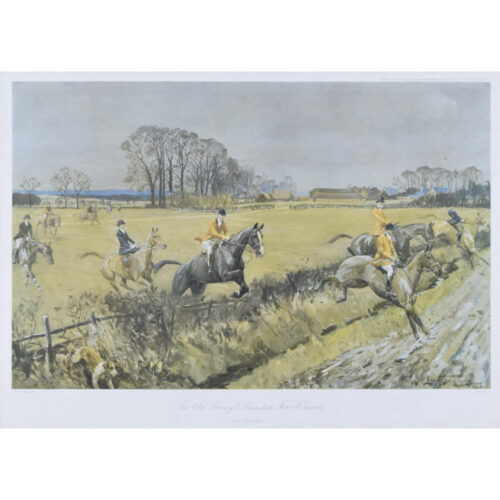
Lionel Edwards (1878 - 1966)
The Old Surrey and Burstow Fox Hounds - at Burstow (1926)
Lithograph 36 x 51 cm Signed and dated in plate lower right. In original 3/4" black frame. A Lionel Edwards lithograph depicting the Old Surrey and Burstow - part of the artist's 'Hunting Countries' series. The Old Surrey and Burstow (now the Old Surrey, Burstow and West Kent Hunt) has been hunting from Felbridge since 1909. The Burstow dates as a foxhound pack from 1866, having previously existed as a harrier pack. Lionel Edwards was a British artist who specialised in pictures of country life, particularly horses, and provided illustrations for Country Life. He is best known for his hunting scenes but also painted pictures of horse racing, shooting and fishing. Condition: print generally good; the odd tiny spot in top right corner. In original 3/4" black frame; some scratches to frame. If you are interested, please email info@manningfineart.co.uk or call us on 07929 749056. Click here for other hunting pictures. -
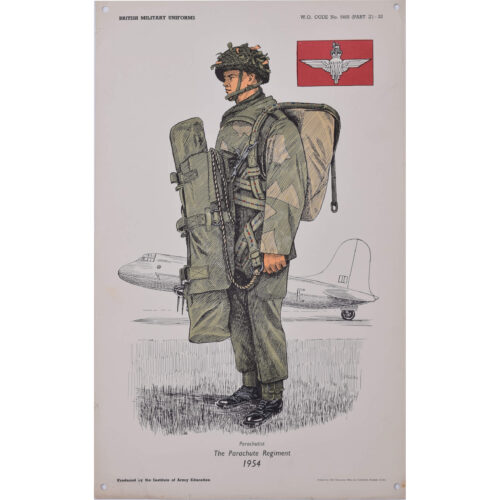
The Parachute Regiment Parachutist 1954 uniform
Lithograph 50 x 31 cm Produced for the Institute of Army Education. Printed for HM Stationery Office by I A Limited, Southall 51. These posters were produced by the Institute of Army Education, likely for display in barracks. Created in the 1950s, they illustrate the 'vintage' uniforms worn by the Corps during the First World War. Condition: punched holes to corners as issued; otherwise generally very good. If you are interested, please email info@manningfineart.co.uk or call us on 07929 749056. Click here for other original vintage Institute of Army Education uniform posters. -
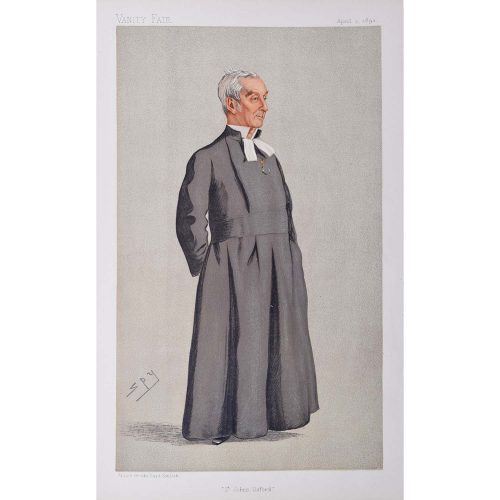
Vanity Fair Spy Magazine President of St john's College Oxford
1 April 1893 Lithograph If you are interested email info@manningfineart.co.uk or call us on 07929 749056. Condition: Good. -
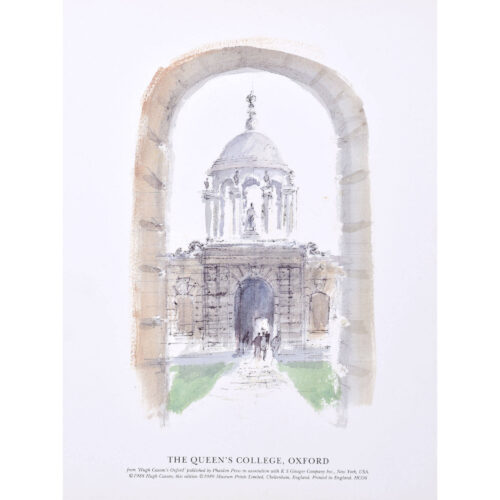
Hugh Casson (1910 - 1999)
The Queen's College, Oxford
Lithograph 30 x 24 cm Casson's view of Queen's, with students heading out to the High Street. Sir Hugh Casson was educated at Eastbourne College; St John’s College, Cambridge; and the Bartlett School of Architecture. Trained in the 1930s in the early modernist style, he taught at the Cambridge School of Architecture. After employment as a camoufleur during World War 2 by the Air Ministry, in 1948 he was appointed as director of architecture for the Festival of Britain. A close friend of the Royal Family, he undertook designs for the 1953 coronation, designed the interior of the Royal Yacht Britannia (“The overall idea was to give the impression of a country house at sea”), and taught the young Charles III to paint in watercolours. Amongst his architectural achievements are the Elephant House at London Zoo, the 1978 redevelopment of Bristol Docks, the Raised Faculty Building for The University of Cambridge, and a building for the Royal College of Art. He published a number of illustrated books, of which Casson’s Oxford and Casson’s Cambridge are probably the best known. A limited edition series of prints was produced from the paintings. Condition: very good; mounted to board. If you are interested, please email info@manningfineart.co.uk or call us on 07929 749056. Click here for other views of Queen's College, Oxford. -
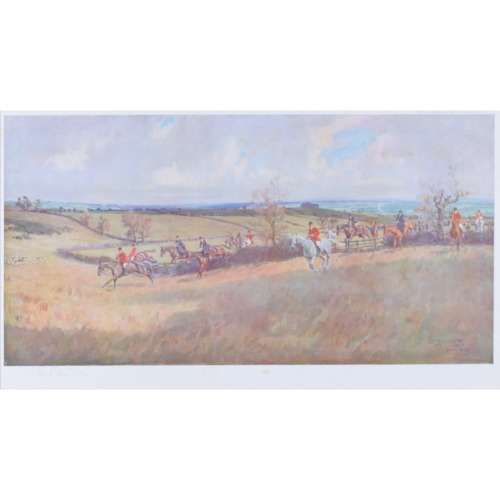
Lionel Edwards (1878 - 1966)
The Quorn Hunt (1934)
Lithograph 34 x 62 cm Signed, titled and dated in plate lower right. Signed in pencil outside plate lower left. A Lionel Edwards lithograph depicting the Quorn - part of the artist's 'Hunting Countries' series. The Quorn Hunt has a claim to be the oldest hunt in the country, being founded in 1696 by Mr Thomas Boothby of Tooley Park, Leicestershire. The hunt takes its name from the village of Quorn, where the hounds were kennelled from 1753 to 1904. Lionel Edwards was a British artist who specialised in pictures of country life, particularly horses, and provided illustrations for Country Life. He is best known for his hunting scenes but also painted pictures of horse racing, shooting and fishing. Condition: print generally good; a couple of very small brown spots. Original 3/4" black frame in generally good condition. If you are interested, please email info@manningfineart.co.uk or call us on 07929 749056. Click here for other hunting pictures. -
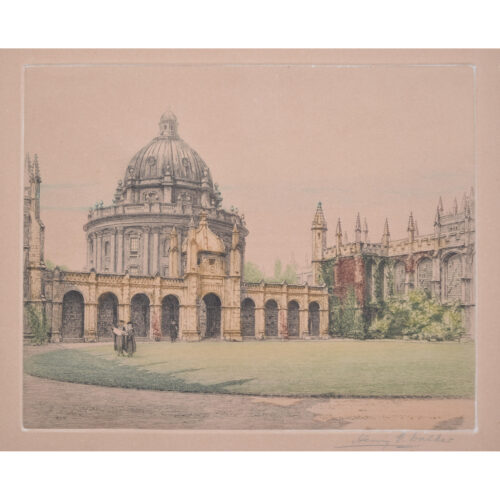
Henry George Walker (1876 - 1932)
The Radcliffe Camera from All Souls College, Oxford
Etching 20 x 25 cm Signed lower right in pencil. The artist depicts the North Quadrangle of All Souls, with the Radcliffe Camera peeking in. Two fellows contemplate a document as a third approaches. Henry Walker was born in Birmingham and specialised in architectural and landscape etchings. Condition: generally very good. If you’d like to know more, please email info@manningfineart.co.uk or call us on 07929 749056. Click here for other views of All Souls. -
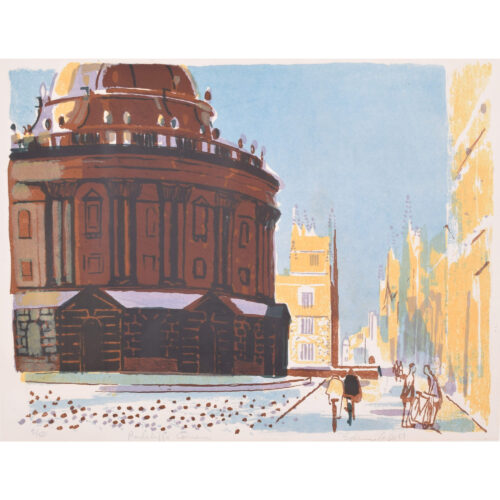
Edwin La Dell (1914-1970)
The Radcliffe Camera, Oxford
Lithograph 41 x 54 cm Numbered 2/50, titled, and signed below in pencil. Radcliffe Square in autumn shades. The Radcliffe Camera dominates the lithograph, and La Dell expertly captures the afternoon sun on the golden stone of Brasenose and the University Church. Students cycle towards the High. La Dell studied at the Sheffield School of Art, where he won a scholarship to the Royal College of Art. From 1934 to 1940 John Nash was the head of printmaking there, and taught La Dell. La Dell himself became head of lithography there in 1948, and remained in post until his death. During the war La Dell was an official war artist and a camofleur, but he is probably best known for his lithographs of Oxford and Cambridge that he published himself. His works are widely held in the public collections, including the Royal Academy and the Government Art Collection, the latter of which holds many of his views of Cambridge. Condition: generally very good. Fractional age-toning to paper; old glue marks to margin which will be under the mount when framed. If you are interested, please email info@manningfineart.co.uk or call us on 07929 749056. Click here for other general views of Oxford. -
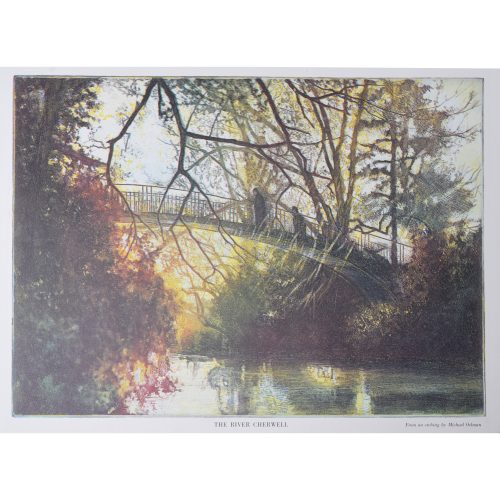
Michael Oelman (born 1941)
The River Cherwell
Lithograph 33 x 46 cm A lithograph of Oxford's wondrous River Cherwell in University Parks, from an etching by Michael Oelman. A setting sun casts its gold light over the glassy surface of the river and its surrounding trees; two figures cross the Cherwell via the famous Rainbow Bridge. The curved footbridge was built in the early 1920s by the University a project for the unemployed. Oelman's etching was reproduced as a lithograph in 1981, to be published in the "Oxford Almanack". The Oxford Almanack was an annual almanac published by the Oxford University Press for the University of Oxford from 1674 through 2019 (when printing sadly ceased due to "dwindling interest"). The almanac traditionally included engravings or lithographs of the University and information about the upcoming year. Other almanac artists have included James Basire, Michael Burghers, J. M. W. Turner, and John Piper. Michael Oelman was born in Llandudno, Wales, in 1941. He studied fine art at Reading University and then etching and lithography at the Central and Slade Schools of Art. In the 1960s he studied with S. W. Hayter in Paris, and then became a lecturer in Printmaking at Doncaster College of Art, Yorkshire. His studio is in Suffolk. Condition: very good. If you’d like to know more, please email info@manningfineart.co.uk or call us on 07929 749056. -
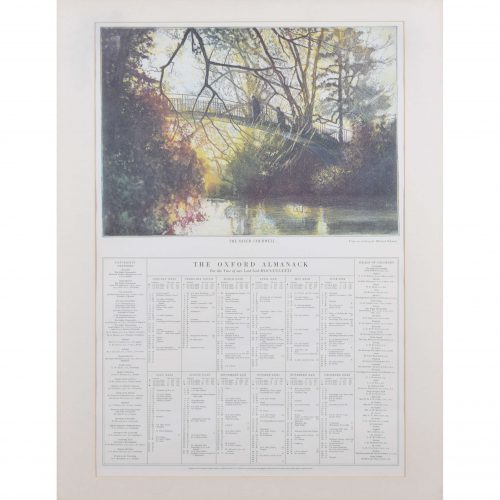
after Michael Oelman (born 1941)
The River Cherwell, The Oxford Almanac 1981
Lithograph 71 x 47 cm A lithograph featuring Oxford's wondrous River Cherwell in University Parks, after an etching by Michael Oelman. A setting sun casts its gold light over the glassy surface of the river and its surrounding trees; two figures cross the Cherwell via the famous Rainbow Bridge. The curved footbridge was built in the early 1920s by the University a project for the unemployed. Oelman's etching was reproduced as a lithograph in 1981, to be published in the "Oxford Almanack". The Oxford Almanack was an annual almanac published by the Oxford University Press for the University of Oxford from 1674 through 2019 (when printing sadly ceased due to "dwindling interest"). The almanac traditionally included engravings or lithographs of the University and information about the upcoming year. Other almanac artists have included James Basire, Michael Burghers, J. M. W. Turner, and John Piper. Michael Oelman was born in Llandudno, Wales, in 1941. He studied fine art at Reading University and then etching and lithography at the Central and Slade Schools of Art. In the 1960s he studied with S. W. Hayter in Paris, and then became a lecturer in Printmaking at Doncaster College of Art, Yorkshire. His studio is in Suffolk. Condition: very good. If you are interested, please email info@manningfineart.co.uk or call us on 07929 749056. Click here for other general views of Oxford. -
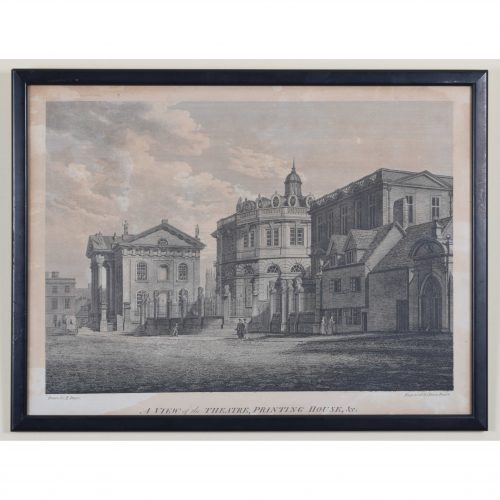
James Basire II (1769 - 1822) after Edward Dayes (1763 - 1804)
A View of the Theatre, Printing House, & c. (1800)
Engraving 36 x 49 cm A view of Broad Street, showing the Clarendon Building, Sheldonian Theatre, and what is now the Museum of the History of Science. Edward Dayes' drawing was reproduced as a lithograph in 1800, to be published in the "Oxford Almanack". The Oxford Almanack was an annual almanack published by the Oxford University Press for the University of Oxford from 1674 through 2019 (when printing sadly ceased due to "dwindling interest"). The almanack traditionally included engravings or lithographs of the University and information about the upcoming year. Other almanack artists have included Michael Burghers, J. M. W. Turner, and John Piper. Basire and Dayes collaborated on several views of Oxford during the courses of their careers. Edward Dayes was a British painter and engraver. He exhibited topographical views at the Royal Academy from 1786 until his death, and is the author of an ''Excursion through Derbyshire and Yorkshire,'' ''Essays on Painting; Instructions for Drawing and Colouring Landscapes'', and ''Professional Sketches of Modem Artists''. James Basire II was a British engraver, son of James Basire I, also a celebrated engraver. In 1802 he became Engraver to the Society of Antiquaries. Condition: some browning, as visible in photograph. If you’d like to know more, please email info@manningfineart.co.uk or call us on 07929 749056. -
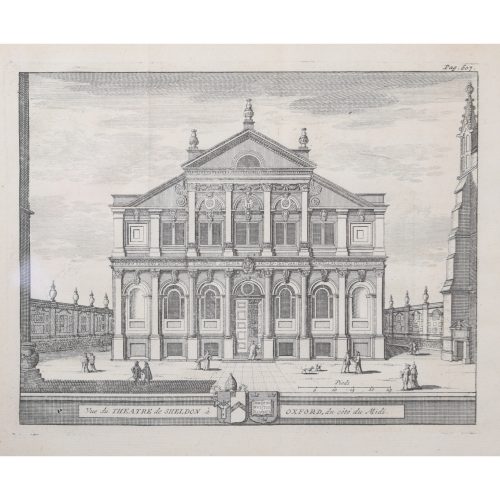
Pieter van der Aa (1659-1733), after David Loggan (1634–1692)
The Sheldonian Theatre, University of Oxford (1727)
Engraving 12 x 16 cm An eighteenth-century view of Oxford's marvellous Sheldonian Theatre, engraved by Pieter van der Aa after David Loggan, the noted engraver, draughtsman, and painter. Christopher Wren designed the building and it was constructed between 1664 and 1669; it takes its name from Gilbert Sheldon, chancellor of the University at the time and the Theatre's main financial backer. Pieter van der Aa of Leiden was a Dutch publisher best known for preparing maps and atlases, though he also printed editions of foreign bestsellers and illustrated volumes. He is noted for the many engravings he produced after David Loggan's series of Oxford and Cambridge colleges and costumes. In 1727 Van Der Aa illustrated "Les Delices de la Grande Bretagne & de L'Irelande" by James Beeverell, the book in which this engraving appears. Condition: a good impression. If you’d like to know more, please email info@manningfineart.co.uk or call us on 07929 749056. -
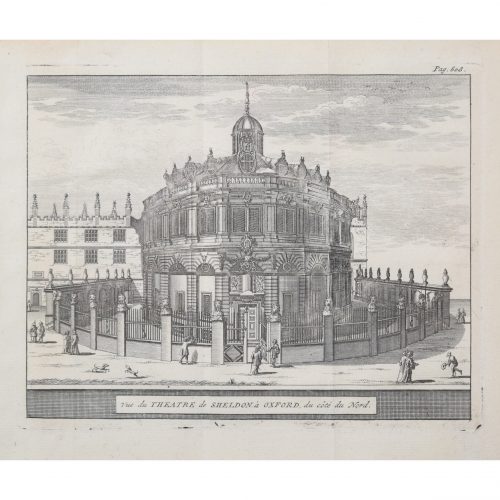
Pieter van der Aa (1659-1733), after David Loggan (1634–1692)
The Sheldonian Theatre, University of Oxford (1727)
Engraving 12 x 16 cm An eighteenth-century view of Oxford's marvellous Sheldonian Theatre, engraved by Pieter van der Aa after David Loggan, the noted engraver, draughtsman, and painter. Christopher Wren designed the building and it was constructed between 1664 and 1669; it takes its name from Gilbert Sheldon, chancellor of the University at the time and the Theatre's main financial backer. Pieter van der Aa of Leiden was a Dutch publisher best known for preparing maps and atlases, though he also printed editions of foreign bestsellers and illustrated volumes. He is noted for the many engravings he produced after David Loggan's series of Oxford and Cambridge colleges and costumes. In 1727 Van Der Aa illustrated "Les Delices de la Grande Bretagne & de L'Irelande" by James Beeverell, the book in which this engraving appears. Condition: a good impression. If you’d like to know more, please email info@manningfineart.co.uk or call us on 07929 749056. -
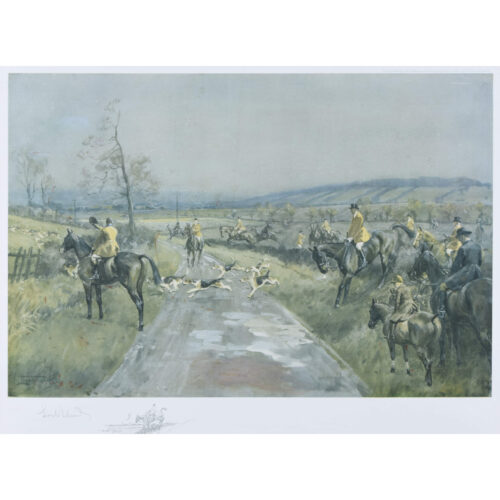
Lionel Edwards (1878 - 1966)
The South Notts Hunt (1928)
Lithograph 31 x 51 cm Signed and dated in plate lower left, and in pencil outside plate lower left. Note to reverse (1988) identifies those illustrated. A Lionel Edwards lithograph depicting the South Notts Hunt - part of the artist's 'Hunting Countries' series. The South Notts country lies in Nottinghamshire and Derbyshire and has been hunted as far back as 1677 by the Earl of Lincoln. In 1775 it was hunted by John Musters, the great-grandfather of John Chaworth-Musters, and in 1860 Mr. John Chaworth-Musters re-established the hunt. Lionel Edwards was a British artist who specialised in pictures of country life, particularly horses, and provided illustrations for Country Life. He is best known for his hunting scenes but also painted pictures of horse racing, shooting and fishing. Condition: print good; original handsome period frame. If you are interested, please email info@manningfineart.co.uk or call us on 07929 749056. Click here for other hunting pictures. -
Out of stock
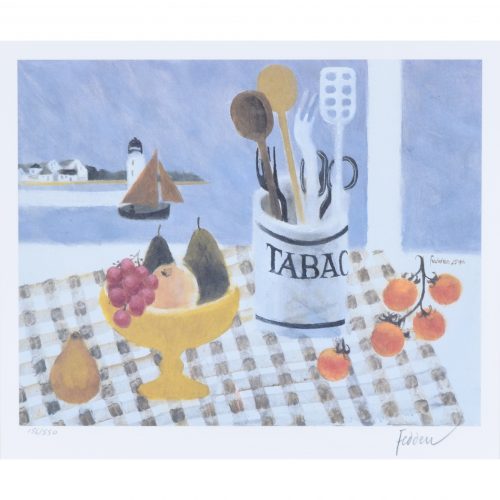
Mary Fedden (1915 - 2012)
The Tabac Jar
Lithograph 26 x 31 cm Signed lower right and numbered 156/550 lower left, both in pencil; signed and dated 1996 in the plate. A typically Fedden still life: a fruit bowl, jug of utensils, and vine of tomatoes on a gingham tablecloth. Beyond the table, a harbour scene including whitewashed buildings, sailing boat, and lighthouse. The form of the objects in her still life composition, and her lilting use of perspective, are immediately recognisable as Fedden's style. Mary Fedden was a Bristol-born artist who studied at the Slade School of Art in London in the 1930s. She painted sets for ballets at Sadlers Wells, then went on to teach art and paint portraits in Bristol. During the war she served in the Land Army and the Woman's Voluntary Service, and then worked in London as a stage painter for the Arts Theatre. In 1944 she went overseas as a driver for the Navy, Army and Air Force Institutes. In 1946 she resumed easel painting and held her first exhibition at the Mansard Gallery in Heal's Department Store in 1947. In 1951 she married the artist Julian Trevelyan, and the couple travelled the world together. She began to teach painting at the Royal Academy in the late 1950s and was elected RA in 1992. She lived and worked in her Durham Wharf studio from 1949 until her death. Condition: generally very good; framed. If you are interested, please email info@manningfineart.co.uk or call us on 07929 749056. Click here for other pictures by Mary Fedden. -
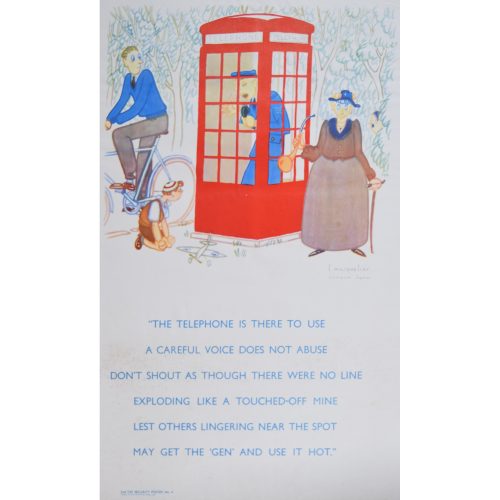
Louis Masquelier (1898-1945)
The Telephone
L. Masquelier/ Lorraine Sqdrn. (2nd TAF Security Poster No.4) Lithographic Poster 55x34.5cm Issued by the 2nd Tactical Airforce ('TAF'). This was a combination of both fighter and bomber units formed for the purposes of supporting the army in the 1944 invasion of Europe. The artist was a Sergent-chef (sergeant) in No 342 (Lorraine) Squadron RAF, a Free French Squadron transferred back to the Armée de l'Air in December 1945. An air gunner - and relatively old at 41 at the beginning of the war - he flew on many operations, also serving as cine-cameraman thanks to his artistic skills. He died on 28 May 1945, after the end of the war. Here a Frenchman has depicted that most English of items, Giles Gilbert Scott's K2 telephone box warning members of the 2nd TAF to be careful when using the telephone. If you are interested email info@manningfineart.co.uk or call us on 07929 749056. -
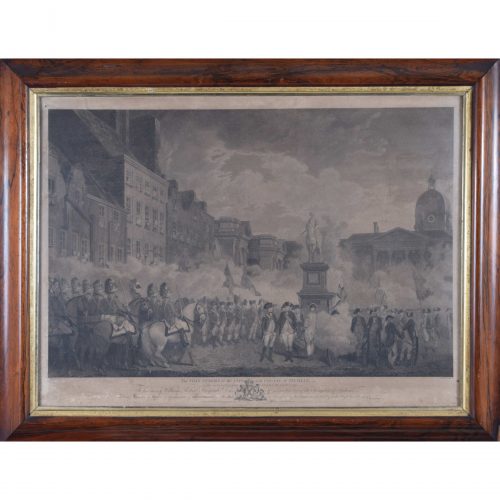
Joseph Collyer (1748 - 1827) after Francis Wheatley (1747 - 1801)
The Volunteers of the City and County of Dublin
Monochrome print 28 x 31 cm A monochrome print depicting Dublin regiments of the Irish Volunteers meeting on College Green. Francis Wheatley depicted the scene in oils in 1779, and Joseph Collyer engraved it in 1781. Wheatley went to Dublin in 1779 and established himself there as a portrait-painter; this view of the Dublin Volunteers became the basis for a best-selling print bought by numerous Irish Patriots. Volunteers were local Irish militias raised by community initiative in Ireland in 1778. Their original purpose was to guard against invasion and to preserve law and order at a time when British soldiers were withdrawn from Ireland to fight abroad during the American Revolutionary War and the government failed to organise its own militia. Taking advantage of Britain's preoccupation with its rebelling American colonies, the Volunteers were able to pressure Westminster into conceding legislative independence to the Dublin parliament. Francis Wheatley was an English portrait and landscape painter who studied at the Royal Academy, and won several prizes from the Society of Arts. He was elected an associate of the Royal Academy in 1790, and an academician in the following year. Joseph Collyer was a British engraver. In 1770 where he exhibited at the Royal Academy for the first time; he was elected an associate engraver of the Royal Academy, and appointed portrait engraver to Queen Charlotte in 1786. Condition: fair. Some browning and staining. In handsome rosewood frame. If you are interested, please email info@manningfineart.co.uk or call us on 07929 749056. -
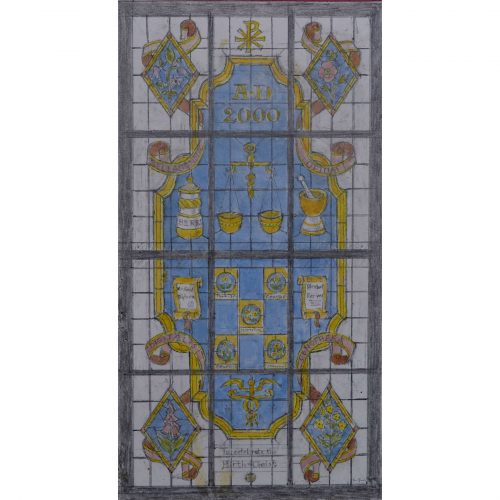
Jane Gray (b.1931)
The Worshipful Society of Apothecaries, Design for Stained Glass Millennium Window (1999)
Watercolour 25 x 13.5 cmSigned.
The Worshipful Society of Apothecaries was founded in 1617, after breaking away from the Grocers’ Company (founded 1345). The Society were granted a royal charter by James I, and, throughout the remainder of the 17th century, challenged the College of Physicians monopoly on practicing medicine. In 1704, the House of Lords overturned a ruling of the Queen’s Bench that gave apothecaries the right to practice medicine. Apothecaries, therefore, may be viewed as the forerunners of present-day general (medical) practitioners or family physicians. Gray’s design for this 2000 memorial window, in the Apothecaries Hall in Blackfriars, London, features the names and illustrations of several medicinal plants, including Belladonna, Opium, Digitalis, Oenothara, Primrose, Cowslip, Nasturtium, Camomile, and Marigold.
Provenance: the artist’s studio sale. Condition: very good. If you are interested, please email info@manningfineart.co.uk or call us on 07929 749056. For other works by Jane Gray and more information about her, please click here. -
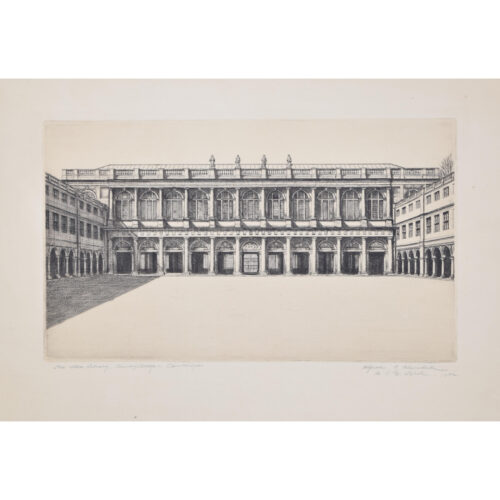
Alfred Richard Blundell (1883 - 1968)
The Wren Library, Trinity College, Cambridge
Etching 15 x 25 cm Signed, titled and inscribed 'to C A Walsh 1952' in pencil. Trinity's magnificent Wren Library was designed by Christopher Wren in 1676 and completed in 1695. Here, the artist captures the library's imposing architectural symmetry. Alfred Blundell was a painter, printmaker and glass engraver who studied at the Slade School of Fine Art. He exhibited at the Royal Academy and the Fitzwilliam Museum, Cambridge holds several of his pictures. Condition: generally very good; old tape reside to very corners. If you are interested, please email info@manningfineart.co.uk or call us on 07929 749056. Click here for other views of Trinity College, Cambridge. -
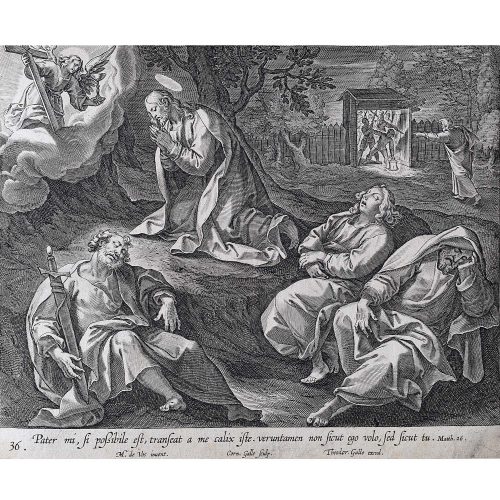
Theodoor Galle (c. 1571-1633) Cornelius Galle (1576-1650) after Maerten de Vos (1532 - 1603) 35. Pater mi, possibile est, transeat a me calix iste. veruntamen non ficut ego volo, sed sicut tu. Matth. 26.
Engraving From Vita, Passio, et Resurrectio Iesu Christi first published 1598, this a later edition published by Joannes Galle (1600-1676) 17.5x22cm From the Gospel of Matthew, Chapter 26 "My Father, if it is possible, may this cup be taken from me. Yet not as I will, but as you will.” Theodoor Galle was the son of Philip Galle, a Dutch publisher best known for his old master prints, from whom he learnt the craft. Theodoor married a daughter of the prominent family of Plantin in Antwerp. His marriage established the productive partnership between the Galle workshop and the Plantin Moretus printing house. A talented workman, Galle quickly became a respected engraver, print publisher and a member of the guild of St Luke, a city guild for artists in 1595. In the years to follow he became the guild's deacon. These particular plates are after paintings by Maerten de Vos, a Flemish painter and draughtsman. His father was Pieter de Vos, from whom he learned. From 1550 - 1558 he travelled in Italy, visiting Rome and Venice and becoming master of the Antwerp Guild of St Luke upon his return in 1558. After 1575 he was mainly engaged in producing print designs. If you are interested email info@manningfineart.co.uk or call us on 07929 749056. Condition: Trimmed to plate margins, generally good condition commensurate with age, slight age toning and handling marks as evident from image. -
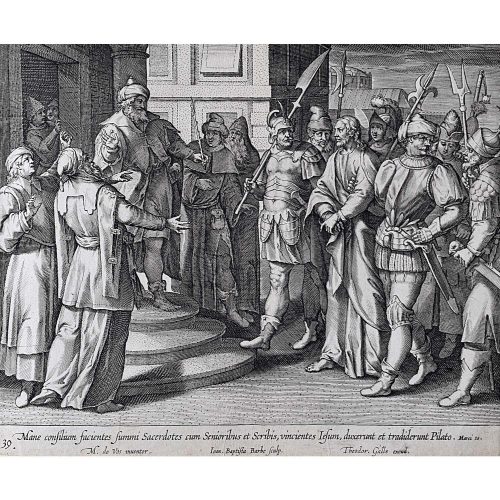
Theodoor Galle (c. 1571-1633) Jan Baptist Barbé (1578-1649) after Maerten de Vos (1532 - 1603) 39. Mane consilium facientes summi sacerdotes cum Senioribus et Scribis, vincientes Iesum, duxerunt et tradiderunt Pilato. Marci. 15.
Engraving From Vita, Passio, et Resurrectio Iesu Christi first published 1598, this a later edition published by Joannes Galle (1600-1676) 17.5x22cm From the Gospel of Mark, Chapter 15 "In the morning, the high priests and elders and teachers, binding Jesus, led him away and delivered him to Pilate." Theodoor Galle was the son of Philip Galle, a Dutch publisher best known for his old master prints, from whom he learnt the craft. Theodoor married a daughter of the prominent family of Plantin in Antwerp. His marriage established the productive partnership between the Galle workshop and the Plantin Moretus printing house. A talented workman, Galle quickly became a respected engraver, print publisher and a member of the guild of St Luke, a city guild for artists in 1595. In the years to follow he became the guild's deacon. These particular plates are after paintings by Maerten de Vos, a Flemish painter and draughtsman. His father was Pieter de Vos, from whom he learned. From 1550 - 1558 he travelled in Italy, visiting Rome and Venice and becoming master of the Antwerp Guild of St Luke upon his return in 1558. After 1575 he was mainly engaged in producing print designs. If you are interested email info@manningfineart.co.uk or call us on 07929 749056. Condition: Trimmed to plate margins, generally good condition commensurate with age, slight age toning and handling marks as evident from image. -
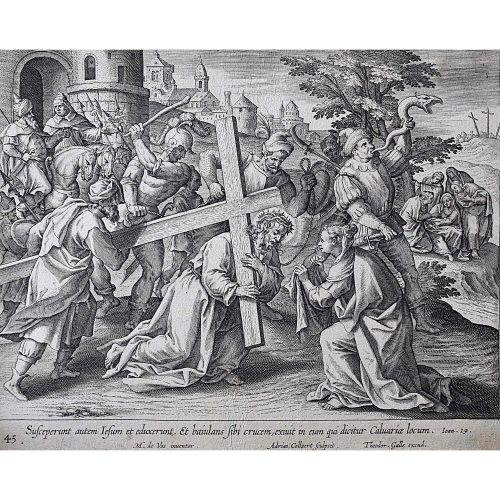
Theodoor Galle (c. 1571-1633) Adrian Collaert (c.1560-1618) after Maerten de Vos (1532 - 1603) 45. Susceperunt autem Iesum eduxerunt. Et baiulans sibi crucem, exiuit in eum qui dicitur Caluarie locum. Ioan. 19.
Engraving From Vita, Passio, et Resurrectio Iesu Christi first published 1598, this a later edition published by Joannes Galle (1600-1676) 17.5x22cm From the Gospel of John, Chapter 19 "And He, bearing His cross, went out to a place called the Place of a Skull." Theodoor Galle was the son of Philip Galle, a Dutch publisher best known for his old master prints, from whom he learnt the craft. Theodoor married a daughter of the prominent family of Plantin in Antwerp. His marriage established the productive partnership between the Galle workshop and the Plantin Moretus printing house. A talented workman, Galle quickly became a respected engraver, print publisher and a member of the guild of St Luke, a city guild for artists in 1595. In the years to follow he became the guild's deacon. Adriaen Collaert was born in Antwerp between 1555 and 1565, becoming wijnmeester of the Guild of St Luke in 1580 - a title reserved for the sons of guild members. The guild of St Luke was generally the city guild for artists. Working for Philip Galle, a Dutch publisher best known for his old master prints, he married Galle's daughter Justa. After learning the principles of engraving in the Netherlands, he spent some years in Italy improving his skill. Upon returning to Flanders he engraved, in accomplished fashion, a great number of plates. His brother, Jan Collaert II, his son, Jan Baptist Collaert II and a grandson were all printmakers. These particular plates are after paintings by Maerten de Vos, a Flemish painter and draughtsman. His father was Pieter de Vos, from whom he learned. From 1550 - 1558 he travelled in Italy, visiting Rome and Venice and becoming master of the Antwerp Guild of St Luke upon his return in 1558. After 1575 he was mainly engaged in producing print designs. If you are interested email info@manningfineart.co.uk or call us on 07929 749056. Condition: Trimmed to plate margins, generally good condition commensurate with age, slight age toning and handling marks as evident from image. -
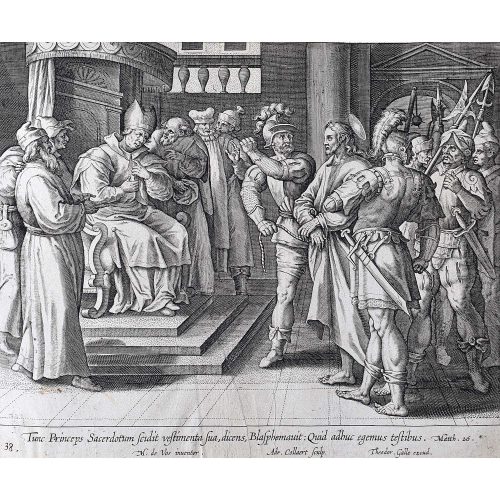
Theodoor Galle (c. 1571-1633) Adrian Collaert (1560-1618) after Maerten de Vos (1532 - 1603) 38. Tunc Princeps Sacerdotum scidit veftimenta sua, dicens, Blasphemauit: Quid adhuc egemus testibus. Matth. 26.
Engraving From Vita, Passio, et Resurrectio Iesu Christi first published 1598, this a later edition published by Joannes Galle (1600-1676) 17.5x22cm From the Gospel of Matthew, Chapter 26 "Then the high priest tore his clothes, saying, “He has spoken blasphemy! What further need do we have of witnesses?” Theodoor Galle was the son of Philip Galle, a Dutch publisher best known for his old master prints, from whom he learnt the craft. Theodoor married a daughter of the prominent family of Plantin in Antwerp. His marriage established the productive partnership between the Galle workshop and the Plantin Moretus printing house. A talented workman, Galle quickly became a respected engraver, print publisher and a member of the guild of St Luke, a city guild for artists in 1595. In the years to follow he became the guild's deacon. These particular plates are after paintings by Maerten de Vos, a Flemish painter and draughtsman. His father was Pieter de Vos, from whom he learned. From 1550 - 1558 he travelled in Italy, visiting Rome and Venice and becoming master of the Antwerp Guild of St Luke upon his return in 1558. After 1575 he was mainly engaged in producing print designs. If you are interested email info@manningfineart.co.uk or call us on 07929 749056. Condition: Trimmed to plate margins, generally good condition commensurate with age, slight age toning and handling marks as evident from image. -
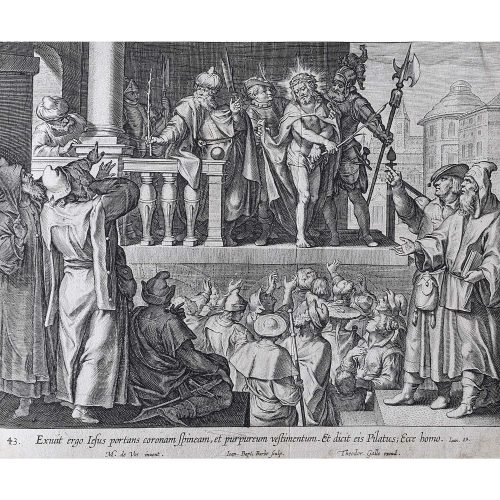
Theodoor Galle (c. 1571-1633) Jan Baptist Barbe (1578-1649) after Maerten de Vos (1532 - 1603) 43. Exiuit ergo Iesus portans coronam spineam, et purpureum vestimentum. Et dicit eis Pilatus; Ecce homo. Ioan. 19.
Engraving From Vita, Passio, et Resurrectio Iesu Christi first published 1598, this a later edition published by Joannes Galle (1600-1676) 17.5x22cm From the Gospel of John, Chapter 19 "Then Jesus came out, wearing the crown of thorns and the purple robe. And Pilate said to them, Behold the Man!" Theodoor Galle was the son of Philip Galle, a Dutch publisher best known for his old master prints, from whom he learnt the craft. Theodoor married a daughter of the prominent family of Plantin in Antwerp. His marriage established the productive partnership between the Galle workshop and the Plantin Moretus printing house. A talented workman, Galle quickly became a respected engraver, print publisher and a member of the guild of St Luke, a city guild for artists in 1595. In the years to follow he became the guild's deacon. These particular plates are after paintings by Maerten de Vos, a Flemish painter and draughtsman. His father was Pieter de Vos, from whom he learned. From 1550 - 1558 he travelled in Italy, visiting Rome and Venice and becoming master of the Antwerp Guild of St Luke upon his return in 1558. After 1575 he was mainly engaged in producing print designs. If you are interested email info@manningfineart.co.uk or call us on 07929 749056. Condition: Trimmed to plate margins, generally good condition commensurate with age, slight age toning and handling marks as evident from image. -
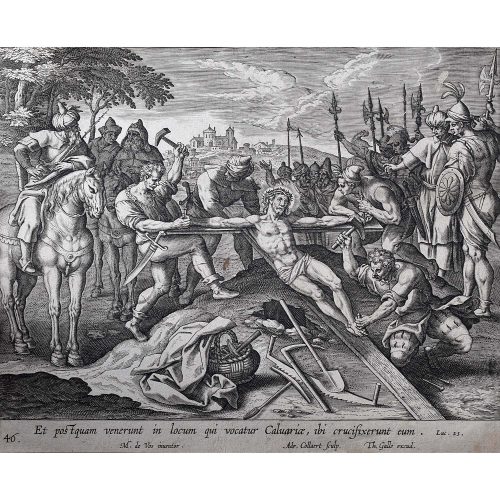
Theodoor Galle (c. 1571-1633) Adrian Collaert (c.1560-1618) after Maerten de Vos (1532 - 1603) 46. Et postquam venerunt in locum qui voctur Caluarie, ibi crucifixerunt eum. Luc. 23.
Engraving From Vita, Passio, et Resurrectio Iesu Christi first published 1598, this a later edition published by Joannes Galle (1600-1676) 17.5x22cm From the Gospel of Luke, Chapter 23 "When they came to the place called the Skull, they crucified him there." Theodoor Galle was the son of Philip Galle, a Dutch publisher best known for his old master prints, from whom he learnt the craft. Theodoor married a daughter of the prominent family of Plantin in Antwerp. His marriage established the productive partnership between the Galle workshop and the Plantin Moretus printing house. A talented workman, Galle quickly became a respected engraver, print publisher and a member of the guild of St Luke, a city guild for artists in 1595. In the years to follow he became the guild's deacon. Adriaen Collaert was born in Antwerp between 1555 and 1565, becoming wijnmeester of the Guild of St Luke in 1580 - a title reserved for the sons of guild members. The guild of St Luke was generally the city guild for artists. Working for Philip Galle, a Dutch publisher best known for his old master prints, he married Galle's daughter Justa. After learning the principles of engraving in the Netherlands, he spent some years in Italy improving his skill. Upon returning to Flanders he engraved, in accomplished fashion, a great number of plates. His brother, Jan Collaert II, his son, Jan Baptist Collaert II and a grandson were all printmakers. These particular plates are after paintings by Maerten de Vos, a Flemish painter and draughtsman. His father was Pieter de Vos, from whom he learned. From 1550 - 1558 he travelled in Italy, visiting Rome and Venice and becoming master of the Antwerp Guild of St Luke upon his return in 1558. After 1575 he was mainly engaged in producing print designs. If you are interested email info@manningfineart.co.uk or call us on 07929 749056. Condition: Trimmed to plate margins, generally good condition commensurate with age, slight age toning and handling marks as evident from image. -
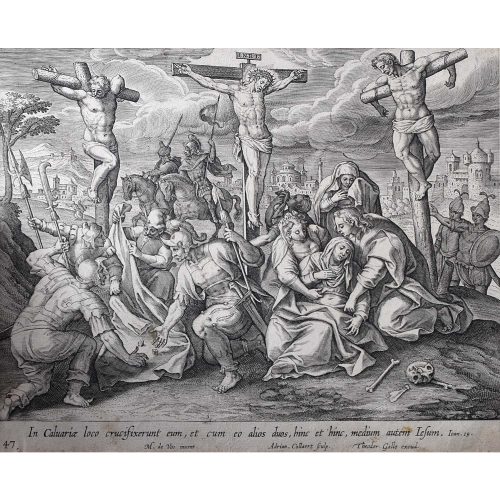
Theodoor Galle (c. 1571-1633) Adrian Collaert (c.1560-1618) after Maerten de Vos (1532 - 1603) 47. In Caluarie loco crucifixerunt eum, et cum eo alios duos, hinc, medium autem Iesum. Ioan. 19.
Engraving From Vita, Passio, et Resurrectio Iesu Christi first published 1598, this a later edition published by Joannes Galle (1600-1676) 17.5x22cm From the Gospel of John, Chapter 19 "There they crucified him, and with him two others—one on each side and Jesus in the middle." Theodoor Galle was the son of Philip Galle, a Dutch publisher best known for his old master prints, from whom he learnt the craft. Theodoor married a daughter of the prominent family of Plantin in Antwerp. His marriage established the productive partnership between the Galle workshop and the Plantin Moretus printing house. A talented workman, Galle quickly became a respected engraver, print publisher and a member of the guild of St Luke, a city guild for artists in 1595. In the years to follow he became the guild's deacon. Adriaen Collaert was born in Antwerp between 1555 and 1565, becoming wijnmeester of the Guild of St Luke in 1580 - a title reserved for the sons of guild members. The guild of St Luke was generally the city guild for artists. Working for Philip Galle, a Dutch publisher best known for his old master prints, he married Galle's daughter Justa. After learning the principles of engraving in the Netherlands, he spent some years in Italy improving his skill. Upon returning to Flanders he engraved, in accomplished fashion, a great number of plates. His brother, Jan Collaert II, his son, Jan Baptist Collaert II and a grandson were all printmakers. These particular plates are after paintings by Maerten de Vos, a Flemish painter and draughtsman. His father was Pieter de Vos, from whom he learned. From 1550 - 1558 he travelled in Italy, visiting Rome and Venice and becoming master of the Antwerp Guild of St Luke upon his return in 1558. After 1575 he was mainly engaged in producing print designs. If you are interested email info@manningfineart.co.uk or call us on 07929 749056. Condition: Trimmed to plate margins, generally good condition commensurate with age, slight age toning and handling marks as evident from image. -
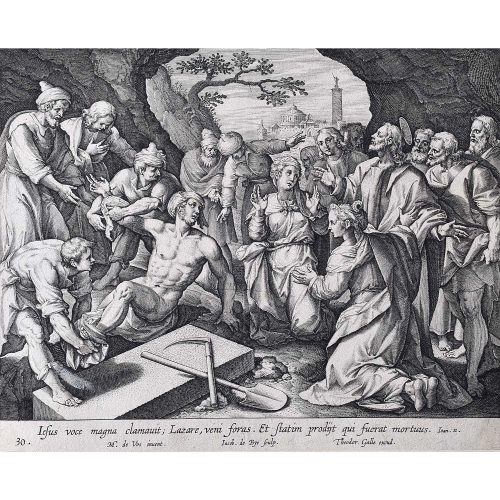
Theodoor Galle (c. 1571-1633) Jacob de Bye (1685-?) after Maerten de Vos (1532 - 1603) 30. Iesus voce magna clamauit; Lazare, veni foras. Et statim proijt qui fuerat mortuus. Iohn. 11.
Engraving From Vita, Passio, et Resurrectio Iesu Christi first published 1598, this a later edition published by Joannes Galle (1600-1676) 17.5x22cm From the Gospel of John, chapter 11 "Jesus called in a loud voice, “Lazarus, come out!” The dead man came out.” Theodoor Galle was the son of Philip Galle, a Dutch publisher best known for his old master prints, from whom he learnt the craft. Theodoor married a daughter of the prominent family of Plantin in Antwerp. His marriage established the productive partnership between the Galle workshop and the Plantin Moretus printing house. A talented workman, Galle quickly became a respected engraver, print publisher and a member of the guild of St Luke, a city guild for artists in 1595. In the years to follow he became the guild's deacon. These particular plates are after paintings by Maerten de Vos, a Flemish painter and draughtsman. His father was Pieter de Vos, from whom he learned. From 1550 - 1558 he travelled in Italy, visiting Rome and Venice and becoming master of the Antwerp Guild of St Luke upon his return in 1558. After 1575 he was mainly engaged in producing print designs. If you are interested email info@manningfineart.co.uk or call us on 07929 749056. Condition: Trimmed to plate margins, generally good condition commensurate with age, slight age toning and handling marks as evident from image. -
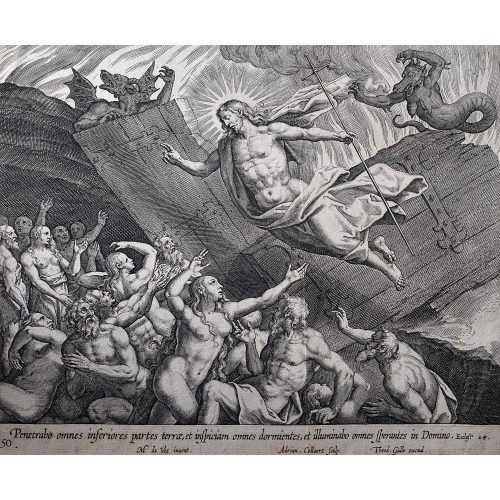
Theodoor Galle (c. 1571-1633) Jan Collaert (1545-1628) after Maerten de Vos (1532 - 1603) 50. Penetrabo omnes inferiores partes terre, et inspiciam omnes dormientes, et illuminabo omnes sperantes in Domino. Eccles. 24.
Engraving From Vita, Passio, et Resurrectio Iesu Christi first published 1598, this a later edition published by Joannes Galle (1600-1676) 17.5x22cm
From the Gospel of Ecclesiasticus, Chapter 24 "Penetrate all the lower parts of the earth, and behold all and illuminate all who hope in the Lord." Theodoor Galle was the son of Philip Galle, a Dutch publisher best known for his old master prints, from whom he learnt the craft. Theodoor married a daughter of the prominent family of Plantin in Antwerp. His marriage established the productive partnership between the Galle workshop and the Plantin Moretus printing house. A talented workman, Galle quickly became a respected engraver, print publisher and a member of the guild of St Luke, a city guild for artists in 1595. In the years to follow he became the guild's deacon. Adriaen Collaert was born in Antwerp between 1555 and 1565, becoming wijnmeester of the Guild of St Luke in 1580 - a title reserved for the sons of guild members. The guild of St Luke was generally the city guild for artists. Working for Philip Galle, a Dutch publisher best known for his old master prints, he married Galle's daughter Justa. After learning the principles of engraving in the Netherlands, he spent some years in Italy improving his skill. Upon returning to Flanders he engraved, in accomplished fashion, a great number of plates. His brother, Jan Collaert II, his son, Jan Baptist Collaert II and a grandson were all printmakers. These particular plates are after paintings by Maerten de Vos, a Flemish painter and draughtsman. His father was Pieter de Vos, from whom he learned. From 1550 - 1558 he travelled in Italy, visiting Rome and Venice and becoming master of the Antwerp Guild of St Luke upon his return in 1558. After 1575 he was mainly engaged in producing print designs. If you are interested email info@manningfineart.co.uk or call us on 07929 749056. Condition: Trimmed to plate margins, generally good condition commensurate with age, slight age toning and handling marks as evident from image. -

Theodoor Galle (c. 1571-1633) Jan Baptist Barbé (1578-1649) after Maerten de Vos (1532 - 1603) 40. Vt cognouit Pilatus quod de Herodis potestate esset, remisit eum Herodem, qui et ipse Hierosolymis erat illis diebus. Luc 23.
Engraving From Vita, Passio, et Resurrectio Iesu Christi first published 1598, this a later edition published by Joannes Galle (1600-1676) 17.5x22cm From the Gospel of Luke, Chapter 23 "When he discovered that he came under Herod’s jurisdiction, he passed him on to Herod who happened to be in Jerusalem at that time." Theodoor Galle was the son of Philip Galle, a Dutch publisher best known for his old master prints, from whom he learnt the craft. Theodoor married a daughter of the prominent family of Plantin in Antwerp. His marriage established the productive partnership between the Galle workshop and the Plantin Moretus printing house. A talented workman, Galle quickly became a respected engraver, print publisher and a member of the guild of St Luke, a city guild for artists in 1595. In the years to follow he became the guild's deacon. These particular plates are after paintings by Maerten de Vos, a Flemish painter and draughtsman. His father was Pieter de Vos, from whom he learned. From 1550 - 1558 he travelled in Italy, visiting Rome and Venice and becoming master of the Antwerp Guild of St Luke upon his return in 1558. After 1575 he was mainly engaged in producing print designs. If you are interested email info@manningfineart.co.uk or call us on 07929 749056. Condition: Trimmed to plate margins, generally good condition commensurate with age, slight age toning and handling marks as evident from image. -
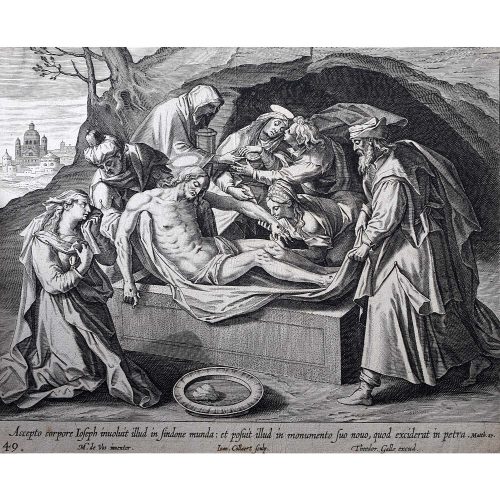
Theodoor Galle (c. 1571-1633) Jan Collaert (1545-1628) after Maerten de Vos (1532 - 1603) 49. Accepto corpore Ioseph inuoluit in sindone munda: et posuit illud in monumento suo nouo, quod exciderat in petra. Matth. 27.
Engraving From Vita, Passio, et Resurrectio Iesu Christi first published 1598, this a later edition published by Joannes Galle (1600-1676) 17.5x22cm From the Gospel of Matthew, Chapter 27 "Taking the body, wrapped in a linen cloth and placed it in his own new tomb, which had been cut into the rock." Theodoor Galle was the son of Philip Galle, a Dutch publisher best known for his old master prints, from whom he learnt the craft. Theodoor married a daughter of the prominent family of Plantin in Antwerp. His marriage established the productive partnership between the Galle workshop and the Plantin Moretus printing house. A talented workman, Galle quickly became a respected engraver, print publisher and a member of the guild of St Luke, a city guild for artists in 1595. In the years to follow he became the guild's deacon. These particular plates are after paintings by Maerten de Vos, a Flemish painter and draughtsman. His father was Pieter de Vos, from whom he learned. From 1550 - 1558 he travelled in Italy, visiting Rome and Venice and becoming master of the Antwerp Guild of St Luke upon his return in 1558. After 1575 he was mainly engaged in producing print designs. If you are interested email info@manningfineart.co.uk or call us on 07929 749056. Condition: Trimmed to plate margins, generally good condition commensurate with age, slight age toning and handling marks as evident from image. -
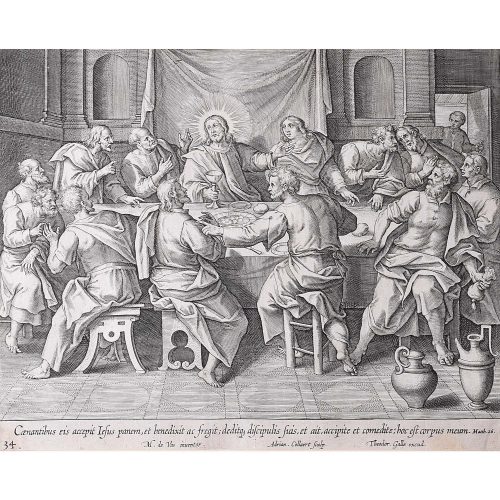
Adriaen Collaert (c. 1560-1618) Jacob de Bye (1581-1640) after Maerten de Vos (1532 - 1603) 34. Coenantibus eis accepit Iesus panem, et benedixit et fregit; deditq discipulis suis, et ait, accipite et comedite; hoc est corpus muem. Matth 16.
Engraving From Vita, Passio, et Resurrectio Iesu Christi first published 1598, this a later edition published by Joannes Galle (1600-1676) 17.5x22cm Hand-finished black frame included (UK shipping only) From the Gospel of Matthew, chapter 16 "And as they were eating, Jesus took bread, and blessed it, and brake it, and gave it to the disciples, and said, Take, eat; this is my body". Theodoor Galle was the son of Philip Galle, a Dutch publisher best known for his old master prints, from whom he learnt the craft. Theodoor married a daughter of the prominent family of Plantin in Antwerp. His marriage established the productive partnership between the Galle workshop and the Plantin Moretus printing house. A talented workman, Galle quickly became a respected engraver, print publisher and a member of the guild of St Luke, a city guild for artists in 1595. In the years to follow he became the guild's deacon. Adrian Collaert was born in Antwerp between 1555 and 1565, becoming wijnmeester of the Guild of St Luke in 1580 - a title reserved for the sons of guild members. The guild of St Luke was generally the city guild for artists. Working for Philip Galle, a Dutch publisher best known for his old master prints, he married Galle's daughter Justa. After learning the principles of engraving in the Netherlands, he spent some years in Italy improving his skill. Upon returning to Flanders he engraved, in accomplished fashion, a great number of plates. His brother, Jan Collaert II, his son, Jan Baptist Collaert II and a grandson were all printmakers. These particular plates are after paintings by Maerten de Vos, a Flemish painter and draughtsman. His father was Pieter de Vos, from whom he learned. From 1550 - 1558 he travelled in Italy, visiting Rome and Venice and becoming master of the Antwerp Guild of St Luke upon his return in 1558. After 1575 he was mainly engaged in producing print designs. If you are interested email info@manningfineart.co.uk or call us on 07929 749056. Condition: Trimmed to plate margins, generally good condition commensurate with age, slight age toning and handling marks as evident from image. -
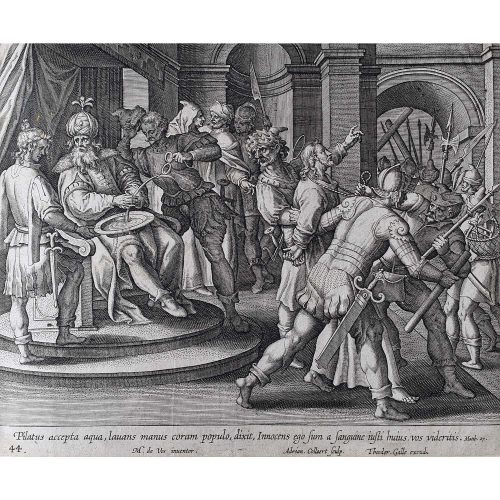
Theodoor Galle (c. 1571-1633) Adrian Collaert (c.1560-1618) after Maerten de Vos (1532 - 1603) 44. Pilatus accepta aqua, lauans manus coram populo, dixit, Innocens ego sum a sanguine insti huius vos videritus. Matth. 27.
Engraving From Vita, Passio, et Resurrectio Iesu Christi first published 1598, this a later edition published by Joannes Galle (1600-1676) 17.5x22cm From the Gospel of Matthew, Chapter 27 "When Pilate saw that he could not prevail at all, but rather that a tumult was rising, he took water and washed his hands before the multitude, saying, “I am innocent of the blood of this just Person. You see to it."" Theodoor Galle was the son of Philip Galle, a Dutch publisher best known for his old master prints, from whom he learnt the craft. Theodoor married a daughter of the prominent family of Plantin in Antwerp. His marriage established the productive partnership between the Galle workshop and the Plantin Moretus printing house. A talented workman, Galle quickly became a respected engraver, print publisher and a member of the guild of St Luke, a city guild for artists in 1595. In the years to follow he became the guild's deacon. Adrian Collaert was born in Antwerp between 1555 and 1565, becoming wijnmeester of the Guild of St Luke in 1580 - a title reserved for the sons of guild members. The guild of St Luke was generally the city guild for artists. Working for Philip Galle, a Dutch publisher best known for his old master prints, he married Galle's daughter Justa. After learning the principles of engraving in the Netherlands, he spent some years in Italy improving his skill. Upon returning to Flanders he engraved, in accomplished fashion, a great number of plates. His brother, Jan Collaert II, his son, Jan Baptist Collaert II and a grandson were all printmakers. These particular plates are after paintings by Maerten de Vos, a Flemish painter and draughtsman. His father was Pieter de Vos, from whom he learned. From 1550 - 1558 he travelled in Italy, visiting Rome and Venice and becoming master of the Antwerp Guild of St Luke upon his return in 1558. After 1575 he was mainly engaged in producing print designs. If you are interested email info@manningfineart.co.uk or call us on 07929 749056. Condition: Trimmed to plate margins, generally good condition commensurate with age, slight age toning and handling marks as evident from image.

